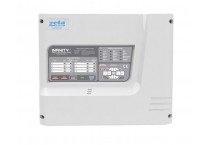What is fire? |
The ancient Greeks believed that fire was one the four basic elements that composed all things in the universe. In the mythology of virtually every culture, fire is a sacred substance that gives life or power. Fire is not, in fact, a substance. When you gaze at the leaping flames of a campfire, you’re observing not an object, but a process – a chemical reaction. It’s the same chemical reaction that occurs when a cut apple left on the counter turns brown, when silver tarnishes or when an iron nail rusts.
That process is oxidation: combining oxygen with another substance. The defining difference between a fire and your half-eaten apple is speed: fire is an oxidation process that happens very fast, so that light, heat and sound are released — often with enough force and majesty to justify the ancients’ reverence. The sudden release of energy causes temperatures to rise, sometimes by thousands of degrees. And it also results in smoke, the toxic waste of fire’s leftovers.
| The fire triangle and the fire tetrahedron |
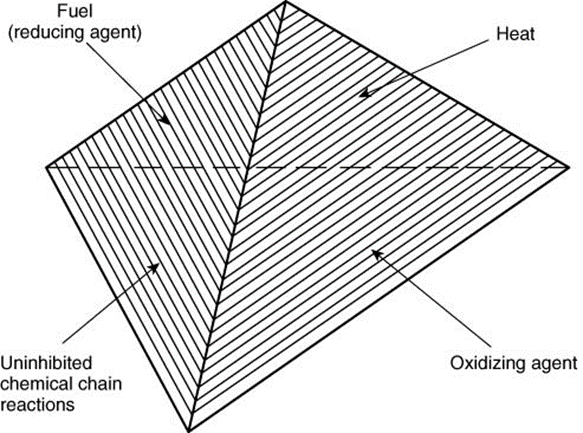 |
The fire triangle identifies the three needed components of fire:
All three components must be present to have a fire. Fire will burn until one or more of the components are removed. Traditional fire extinguishing methods involve removing the fuel, heat, or oxygen. In more recent years, a fourth component – the uninhibited chain reaction – has been added to explain fire. This chain reaction is the feedback of heat to the fuel to produce the gaseous fuel used in the flame. In other words, the chain reaction provides the heat necessary to maintain the fire. The addition of this fourth component (which forms what is called the "fire tetrahedron ") more accurately describes the mechanism for fire suppression by clean agent halon replacements which break up the uninhibited chain reaction of combustion. |
| Stages of fire |
- Ignition: Fuel, oxygen and heat join together in a sustained chemical reaction. At this stage, a fire extinguisher can control the fire.
- Growth: With the initial flame as a heat source, additional fuel ignites. Convection and radiation ignite more surfaces. The size of the fire increases and the plume reaches the ceiling. Hot gases collecting at the ceiling transfer heat, allowing all fuels in a room to come closer to their ignition temperature at the same time.
- Fully developed: Fire has spread over much if not all the available fuel; temperatures reach their peak, resulting in heat damage. Oxygen is consumed rapidly.
- Decay (Burnout): The fire consumes available fuel, temperatures decrease, fire gets less intense.
| How fire spreads |
Fire spreads by transferring the heat energy from the flames in three different ways.
- Conduction: The passage of heat energy through or within a material because of direct contact, such as a burning wastebasket heating a nearby couch, which ignites and heats the drapes hanging behind, until they too burst into flames.
- Convection: The flow of fluid or gas from hot areas to cooler areas. The heated air is less dense, and rises, while cooler air descends. A large fire in an open area produces plume or column of hot gas and smoke high into the air. But inside a room, those rising gases encounter the ceiling. They travel horizontally along the ceiling forming a thick layer of heated air, which then moves downward.
- Radiation: Heat traveling via electromagnetic waves, without objects or gases carrying it along. Radiated heat goes out in all directions, unnoticed until it strikes an object. Burning buildings can radiate heat to surrounding structures, sometimes even passing through glass windows and igniting objects inside.
| Four ways to put out a fire |
- Cool the burning material
- Exclude oxygen
- Remove the fuel
- Break the chemical reaction
| Special circumstances |
- Rollover occurs when ignited fire gases, or incompletely burned fuels, rise to the ceiling, and spread out horizontally. Then smoke appears to suddenly start burning. If nothing is done to ventilate the room or cool the air, this condition leads to flashover.
- Flashover is the sudden, simultaneous ignition of everything in a room. This is how it happens:
- Hot gases rise to the ceiling and spread out across to the walls.
- Heat radiates downward and intensifies until all combustible items reach their ignition temperatures and burst into flames.
- Temperatures soar to as much as 1,000 degrees Fahrenheit in a few seconds. Even a firefighter in full protective gear is unlikely survive a flashover.
- Firefighters are trained to recognize the signs that flashover is about to occur: dense black smoke with tightly packed curls ("black fire"); dense, black smoke that pushes out of a doorway or window opening; smoke that has accumulated as low as a doorknob, with the fire seen below.
- Backdraft is an explosion that occurs when oxygen is introduced into a room full of hot gases.
- A fire burning in a confined area consumes all the oxygen.
- Visible flames disappear. Solid fuels smolder, and hot flammable gases accumulate and fill the room.
- The temperature increases, the gases expand, and pressure builds, pulsing against doors and windows. From outside, the building may look like it is breathing or throbbing.
- If an opening is made to admit oxygen, the hot vaporized fuel bursts into flames, and the pressurized gases explode through the opening, resulting in a rolling fireball.
| Classifying fire |
Fire classifications based on fuel type:
- Class A: Ordinary combustible materials, such as wood, cloth, paper, rubber and many plastics. They burn with an ember and leave an ash. Extinguish by cooling the fuel to a temperature that is below the ignition temp. Water and other extinguishing agents are effective.
- Class B: Flammable liquids (burn at room temperature) and combustible liquids (require heat to ignite). Petroleum greases, tars, oils, oil-based paints, solvents, lacquers, alcohols, and flammable gases. High fire hazard; water may not extinguish. Extinguish by creating a barrier between the fuel and the oxygen, such as layer of foam.
- Class C: Fuels that would be A or B except that they involve energized electrical equipment. Special techniques and agents required to extinguish, most commonly carbon dioxide or dry chemical agents. Use of water is very dangerous because water conducts electricity.
- Class D: Combustible metals, such as magnesium, titanium, zirconium, sodium, lithium and potassium. Most cars contain numerous such metals. Because of extremely high flame temperatures, water can break down into hydrogen and oxygen, enhancing burning or exploding. Extinguish with special powders based on sodium chloride or other salts; also clean dry sand.
- Class K: Fires in cooking appliances that involve combustible cooking media (vegetable or animal oils and fats).
If you want to learn more visit: https://en.wikipedia.org/wiki/Fire
| How Fire-Detection Systems Work |
The field of fire detection has advanced to where smoke detectors and alarm devices have combined to become life-safety systems
 |
Fire is one of the most dangerous events possible; somewhere in the world, one occurs every minute of every day. While fire can be our friend in some instances, it can be our worst enemy when it’s uncontrolled and allowed to continue through a building. Fire is, of course, destructive, and the smoke from a fire creates a toxic, dangerous atmosphere. The rapid detection of a fire and its control can save several thousand lives, thousands of injuries, and millions of euros in property loss each year.
The field of fire detection has advanced to where smoke detectors and alarm devices have combined to become life-safety systems. The purpose of an automatic fire-alarm system is to detect an occurrence, alert the control panel and proper authorities, and notify the occupants to take action. Current Fire-Detection Systems How FACPs Communicate |
The FACP may confirm the findings with other area detectors, thereby reducing the potential for nuisance or false alarms. The FACP may activate the audible and visual notification devices, which will alert the building’s occupants to take action. The notification devices may be a loud horn, a flashing strobe light, a bell, a gong, or a loud speaker that announces verbal instructions to the occupants. It may only activate on certain floors of a building. In high-rise occupancies, it’s common to alert on the fire floor, the floor above, and the floor below. This reduces the need to evacuate an entire building. In a hospital or extended-care facility, the FACP may only notify certain people to allow staff to check out the situation and make a decision for general evacuation.
It’s important to note that all fire alarm and detection systems require periodic care and maintenance. Depending on the local AHJ (authority having jurisdiction), there may be requirements for annual, semi-annual, or monthly system testing. Testing must be conducted by competent, well-trained personnel. A properly installed and maintained system saves lives and reduces property damage.
| HOW FIRE ALARM SYSTEM WORKS |
Fire alarms can be triggered by smoke detectors, heat detectors, or manually. They are generally set to detect levels of smoke or heat that may indicate a fire. There is a loud bell that sounds to alert those in the building. This may also come with lights that blink in case of someone who is hearing impaired. There are many models of fire alarm systems on the market. Research for which one is best can be done on the Internet or by doing a search in your local area for manufacturers. Many fire alarm systems come bundled with intruder alert systems for maximum safety and protection of your home.
There are two costs to a system. The cost of the equipment can either be purchased or leased. The system will need to be installed which may also add a one-time fee. Systems start at approximately 20.00 euro for basic models and range up to 2,000.00 euro for more sophisticated models. For home use, a basic system with monitoring is usually sufficient. These will range anywhere from 100.00 euro to 700.00 euro.
The one time expense of the equipment, installation, and the regular payments for monitoring are a valuable investment. Considering the costs associated with fire damage or the tragedies of losing a life in a fire, the investment is well worth it.
It is important to know what to do in case the alarm goes off. Fire drills are helpful in ensuring everyone in the family knows what to do. Practice this at least annually. If there is a small fire, one person should be in charge of using a fire extinguisher while the others leave the area. For a larger fire, everyone should immediately evacuate the premises and gather at a predetermined location. Once everyone is there, a count should be taken to ensure everyone is out safely. Notify the fire department.
A fire alarm system should be tested annually to ensure it is working properly. Notify the person monitoring the system of this before testing so they do not come out needlessly. False alarms are often charged to the consumer to account for the time wasted. A fire alarm system is a valuable investment. It can help provide safety and security to your family and home
Ever heard of the phrase ‘nip it in the bud’; fire alarm systems are designed to do just that. They are designed to detect fire outbreaks early and give home owners valuable time to take appropriate action or evacuate. This may seem inconsequential; however, it may turn out to be the difference between life and death.
Don’t believe it. Here’s a fact:
‘An individual can lose consciousness in as little as 20 seconds from smoke inhalation’
It takes another 5 – 10 minutes for the brain cells to die, if fresh oxygen is unable to reach the brain.
In this case, a fire alarm system could be a God send and a smart investment. According to a report published by FEMA in April 2013, 35% of fire victims were asleep at the time of their death. This unnecessary loss of life could’ve been avoided with the help of an effective alarm system.
A fire alarm system is basically a network of initiating devices, and notification devices connected to a Fire Alarm Control Panel (FACP) used to alert people of an emergency in a building. Some modern fire alarm systems are remotely monitored by fire alarm monitoring companies who will decipher messages sent from the fire alarm system and decide whether to send the Fire Department, notify building owners / service companies of system troubles, or do nothing at all.
What is an FACP
A Fire Alarm Control Panel is the brains of the fire alarm system. All of the parts on a fire alarm system communicate with the FACP, which in turn decides what to do. Modern FACPs include keypads, LCD screens, and communication ports that make the system easier to work with.
An FACP is generally inside a locked red box located somewhere safe, such as an electrical room, office, or maintenance area. In some cases where there are no available rooms to install the FACP, the FACP might be located somewhere outside the building in a weather proof plastic enclosure.
What is an Initiating Device
An initiating device is a sensor which detects things that are commonly a sign of fires and other hazards, or a switch that makes it possible for building occupants to set off the fire alarm manually when there's an emergency none of the sensors can detect.
Common initiating device sensors include smoke detectors, heat detectors, and water flow detectors on fire sprinklers. Manual initiating devices pretty much consist of various styles of pull stations.
What is a Notification Device
A notification device, or notification appliance, is a device that tells everyone in the building the fire alarm is going off. Common notification appliances include horns / speakers (sounders), strobe lights, and various combinations of the three.
Unfortunately some people are hearing impaired, and other people are vision impaired. Some buildings have areas with a lot of ambient noise that makes it impossible to hear sounders. Some areas in buildings such as public restrooms amplify sound to harmful levels. Some areas such as hospital operating rooms have activities going on in them which could lead to disaster if a sudden loud annoying noise were to be made. Therefore we have notification appliances that can be seen and heard in a building.
In advanced fire alarm systems there may be what's referred to as an EVAC system. An EVAC system is basically an intercom that will play a prerecorded evacuation plan over the loudspeakers when the fire alarm goes off, and make it possible for management to pick up a microphone and communicate with everyone in the building at once.
What is a System Trouble
Modern fire alarm systems monitor themselves for potential problems with the system. When something isn't working the way it should on a fire alarm system, that system is said to be in trouble. Things such as old batteries, old wet notification appliances, smashed or moldy heat detectors, rat-chewed wires, downed phone lines, and closed fire sprinkler valves are just some examples of system troubles modern FACPs monitor.
Keep in mind that the systems can't always tell us exactly what the problem is. "rat chewed wires" and "old wet notification appliances" can both be interpreted by the system as a ground fault. Rat chewed wires could also be interpreted at an open circuit.
If you've determined that your fire alarm system is in trouble, call your fire alarm service company. If you don't know who your alarm service company is, look for stickers on the building's FACP that have phone numbers on them. The FACP will generally have tags / stickers on them the Fire Department uses to help verify the system is getting required periodic inspections. These inspection tags will generally have your fire alarm service company's phone number and other contact details on them.
| Fire Alarm Systems |
The choice of fire alarm system depends on the building structure, the purpose and use of the building and current legislation. In new or altered buildings the enforcement body is the local building control, and the relevant guidance is explained in section new or altered buildings. All existing buildings except domestic premises are subject to The Regulatory Reform (Fire Safety) Order 2005 and the Responsible Person, as defined in the order, has to conduct a fire risk assessment. This FRA will decided the appropriate British standard necessary to provide a suitable and sufficient solution for the premises. The enforcement body is the Fire and Rescue Service and the Department of Communities and Local Government (DCLC) have published a number of guidance documents for premises subject to the RR(FS)O. This is particularly important since none of the legislation gives any detailed information on the type of system required but the guidance usually indicates appropriate British standards. The main standard for fire alarm systems is BS5839 pt1:2013.
This guidance contains brief descriptions of the major components which go to make up a fire alarm system. The points to be considered are intended to highlight the variables which can exist and need to be considered whilst designing and compiling a specification for component parts.
It is not the object of this note to consider the details of different circuit types or to discuss their relative merits.
| Types of Fire Alarm Systems |
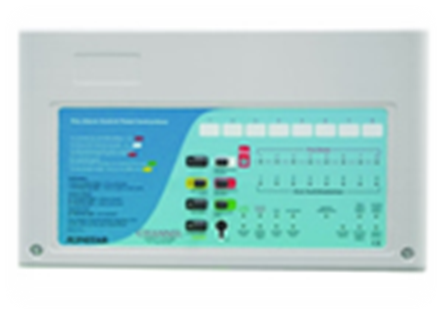 |
All Fire Alarm Systems essentially operate on the same principle. If a detector detects smoke or heat or someone operates a break glass unit (manual break point), then alarm sounders operate to warn others in the building that there may be a fire and to evacuate. It may also incorporate remote signalling equipment which would alert the fire brigade via a central station. Fire Alarm Systems can be broken down into four categories:
Conventional Fire Alarm System |
 |
In a Conventional Fire Alarm System, a number of call points and detectors are wired to the Fire Alarm Control Panel in Zones. A Zone is a circuit and typically one would wire a circuit per floor or fire compartment. The Fire Alarm Control Panel has a number of Zone Lamps. The reason for having Zones is to give a rough idea as to where a fire has occurred. This is important for the fire brigade and of course for the building management. The accuracy of knowing where a fire has started is controlled by the number of Zones a Control Panel has and the number of circuits that have been wired within the building. The Control Panel is wired to a minimum of two sounder circuits which could contain bells, electronic sounders or other audible devices. Each circuit has an end of line device which is used for monitoring purposes.
Addressable Systems |
The detection principle of an Addressable System is similar to a Conventional System except that the Control Panel can determine exactly which detector or call point has initiated the alarm. The detection circuit is wired as a loop and up to 99 devices may be connected to each loop. The detectors are essentially Conventional Detectors, with an address built in. The address in each detector is set by dil switches and the Control Panel is programmed to display the information required when that particular detector is operated. Additional Field Devices are available which may be wired to the loop for detection only i.e. it is possible to detect a normally open contact closing such as sprinkler flow switch, or a normally closed contact opening. Sounders are wired in a minimum of two sounder circuits exactly as a Conventional System. Loop Isolation Modules are available for fitting on to the detection loop/loops such that the loop is sectioned in order to ensure that a short circuit, or one fault will only cause the loss of a minimal part of the system.
Analogue Addressable Fire Alarm Systems
 |
Analogue Addressable Fire Alarm Systems are often known as Intelligent Fire Alarm Systems. There are several different types of Analogue Systems available which are determined by the type of protocol which they use. The bulk of standard Analogue Detectors available are fairly stupid as the Detectors can only give output signals representing the value of detected phenomena. It is left up to the Control Unit to decide whether there is a fire, fault, pre-alarm or other. With a true Intelligent Analogue System each detector effectively incorporates its own computer which evaluates the environment around it, and communicates to the Control Panel whether there is a fire, fault or the detector head needs cleaning. Essentially Analogue Systems are far more complex and incorporate far more facilities than Conventional or Addressable Systems. Their primary purpose is to help prevent the occurrence of false alarms. With the Analogue Addressable System, up to 127 input devices i.e.: Smoke Detectors, Call Points, Heat Detectors, Contact Monitors and other interface devices may be wired to each detection loop. In addition to the 127 Input Devices, up to 32 Output Devices such as Loop Sounders, Relay Modules and Sounder Modules may be connected. Analogue Systems are available in 2, 4 and 8 loop versions which means large premises can be monitored from one single panel. Isolator units should be connected between sections of detectors as described for Addressable Systems |
Wireless Fire Alarm System
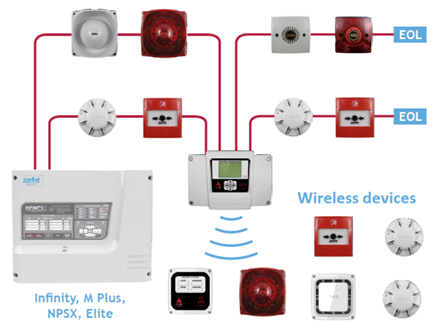 |
Wireless fire alarm systems are an effective alternative to traditional wired fire alarm systems for all applications. They utilise secure, licence-free radio communications to interconnect the sensors and devices (smoke detectors, call-points, etc.) with the controllers. It is a simple concept, which provides many unique benefits and is a full analogue addressable fire detection system without the need for cable. |
| System Design |
Before starting, the designer will need to ensure that certain information is available. This may be given in the specification or it may have to be obtained by consultation. As well as the purchaser, there may be a requirement to consult with other interested parties
Points to consider
- The type of system required i.e. L1, L2, L3 etc and where appropriate, parts of the premises to be covered.
- The action to be taken in the event of fire
- Whether other occupants of a multi occupancy building will be affected
- Whether other work is to be done at the same time. If so then consultation with other contractors may be required.
- A Method of calling the Fire Brigade
- Whether the type of occupants or activity in the building will require a greater provision of Manual Call Points than normal
- A likely attendance time of the Fire Brigade
Control of Indicating Panels
Control and indicating equipment performs three principal functions, namely:
- Automatic monitoring and control of circuits external to the equipment, such as fire detection and fire alarm device circuits and supply of power to these circuits
- Indication of fire signals, fault signals and their location
- Manual control to facilitate actions such as testing, disablement of devices, triggering of fire signals, silencing of audible fire warnings and resetting the system after a fire signal
Panels are fully specified in British Standards. This requires that circuits are monitored continuously and that both audible and visual indication is provided for fault and fire alarm conditions. Further requirements include that alarm sounders may only be silenced manually, after which the control panel must provide audible and visual signals until the system is reset. Silencing of alarm sounders must not prevent the alarm being raised in other zones. It should be noted that the standards require all fault/alarm indicator lamps to be in duplicate or a single lamp with audible signal of lamp failure. Control and indicating panels may include facilities for operation of ancillary services such as fixed fire extinguishing, door closing etc.
The equipment should normally be sited in an area of low fire risk and on the ground floor by the entrance used by the Fire and Rescue Service and preferably viewable from outside of the building. It should be located in an area common to all building users and where automatic detection is in use, the Control Panel should be in a protected area. An alarm sounder should be sited next to the Control Unit, but not too near the telephone position. A suitable zone chart of the building should normally be installed adjacent to the Control Panel.
Points to consider
- Number of zones required
- Surface or flush mounting
- Maximum alarm load per alarm zone
- Automatic system, compliance with British Standard
- Manual system compliance with British Standard
- Maximum current per detector zone
- Maximum detectors per zone
- Open, closed or fault monitored system
- Single or two stage alarms
- Provision for connection to remote manned centre
- Provision for conduit and wiring compatible with
building conduit and wiring system - Provision for operation of ancillary services
| Detector Heads |
These can be divided into four main types Heat detectors, Smoke detectors, Carbon Monoxide detectors and Multi sensors detectors.
Heat detectorsHeat sensitive point detectorsPoint detectors can again be subdivided to a further two types.
Both types are suitable for inclusion in open, closed or line monitored systems. |
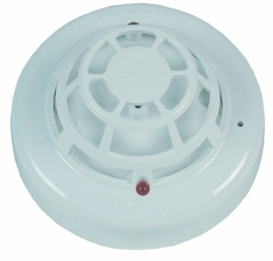 |
Linear detectors
These can take the form of a heat sensitive cable which will operate, at a predetermined temperature, as an open circuit device. Melting of the cable insulation provides a short-circuit between conductors. After operation the destroyed length of cable must be replaced. Linear detectors may be used in large areas such as warehouses. Alternative types of linear detector exist including the heat pneumatic operating on the
rate of rise principle.
Points to consider
- Open, closed, fault monitored circuits
- Temperature setting for fixed temperature fusible elements
- Spare fusible elements
- Surface or flush mountings
- Temperature setting for fusible elements in the rate of rise detection., if included
- Mounting height
- Spacing to manufacturer’s recommendations
- Rate of rise detectors located in positions where abnormal increase in temperature is likely, e.g. space heating equipment, industrial processes
Smoke Detectors
There are three basic types operating by ionization, light scattering and light obscuring.
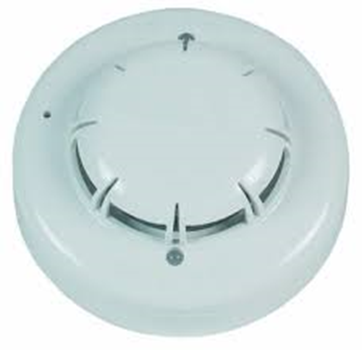 |
IonisationThese generally contain two chambers. One is used as a reference to compensate for changes in ambient temperature, humidity or pressure. The second contains a radioactive source, usually alpha particle, which ionizes the air passing through the chamber where a current flows between two electrodes. When any of the products of combustion enters the chamber the current flow decreases. This drop is used to initiate an alarm. Light obscuringIn the obscuring type the smoke interferes with a light beam between a light source and photo cell, the variation in photo cell output being used to initiate an alarm. This type of detection can be used to protect large areas with the source and photo cell positioned some distance apart. Light scattering |
The light scattering detector operates on the Tyndall effect, a photo cell and light source are separated from each other by a darkened chamber such that the light source does not fall on the photo cell. The passage of smoke into the chamber causes the light from the source to be scattered and fall on the photo cell, the cell output being used to initiate an alarm.
The light scattering and light obscuring detectors both, detect visible smoke. The ionization detector and light scattering detector are normally each a single unit suitable for BESA conduit box mounting. In some models the smoke detector head is attached to the main body by a bayonet fixing for easy removal for maintenance or replacement. It should be noted that some detectors are suitable for two-wire circuits whereas others require three or four wire connections. Smoke detectors require a continuous power supply. Under quiescent conditions they draw a current of some 100 micro amps, and under alarm conditions, some 45 milliamps. This needs to be borne in mind when sizing the power supply. Smoke detectors generally operate on 24 d.c. Refer to British Standard Codes of Practice and manufacturers literature for information regarding the positioning of smoke detectors. Detectors are not suitable for positioning in kitchens, near fireplaces or areas with excessive exhaust fumes, or within 2m of air supply ducts or diffusers.
Carbon Monoxide detector
CO fire detectors are electronic detectors used to indicate the outbreak of fire by sensing the level of carbon monoxide in the air. Carbon monoxide, usually known by its chemical formula CO, is a poisonous gas produced by combustion. They are not the same as CO detectors used for home safety which are used to protect residents against carbon monoxide produced by incomplete combustion in appliances such as gas fires or boilers.
CO fire detectors use the same type of sensor but are more sensitive and respond more quickly.CO detectors have an electrochemical cell, which senses carbon monoxide, but not smoke or any other combustion products. The cells do not require much power, so the detectors can be made electrically compatible with ordinary smoke and heat detectors. As fire detectors they are effective but only for certain types of fire. Deep-seated, smouldering fires produce carbon monoxide, which can be detected some distance from the seat of the fire. For this type of fire a CO fire detector will probably operate before a smoke detector. Smoke detectors, however, will almost always give a better response to a fire that has produced a rising plume of smoke. CO fire detectors will give a poor response to flaming fires. Because CO fire detectors work on different principles from smoke detectors, their false alarm behaviour will be different. For example, they will not be affected by steam, dust, or by most cooking fumes. However, because of their high sensitivity, they may false alarm from harmless transient levels of CO produced by gas heaters starting up, or from vehicle exhaust fumes entering through a window. These events would not affect an optical smoke detector.
As always, the detector must be selected for the application, to achieve the best balance between fire detection capability and false alarms. There are some known disadvantages of CO fire detectors. One is that the electrochemical cells at the heart of the detectors have a limited life typically seven years and that they are not failsafe. The detector might be “dead” with out this fact being apparent. For this reason a means of checking the CO cell has been incorporated. Another clear disadvantage is the poor response to many types of fire, especially life threatening flaming fires.
Multi sensor detector
This detector combines inputs from optical and heat sensors and processes them using a sophisticated algorithm. When polled by the control panel it returns an analogue count which is determined by combined responses from both optical and heat sensors. They are designed to be sensitive to a wide range of fires and may be used in place of an ionisation detector in many instances.
Operating principles
Signals from the optical smoke chamber and temperature sensor are independent, and represent the smoke level and air temperature respectively in the vicinity of the detector; the detector’s micro controller processes both signals. The temperature signal processing extracts only rate of rise information for combination with the smoke signal. The detector will not respond to slow increases in temperature but a large sudden change can cause an alarm without presence of smoke, if sustained for 20 seconds. The processing algorithms in the multi-sensor incorporate drift compensation.
Points to consider
- Open or closed circuit
- Fault monitored circuit
- System voltage
- Surface or flush mounting
- Detector operated indicator
- Two or three-wire system
- Quiescent current demand
- Smoke detector location
- Spare detector heads
| Manual Call Poin |
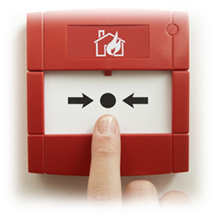 |
A Break Glass Call Point is a device which enables personnel to raise the alarm by breaking the frangible element on the fascia. They should be mounted 1.4m from the floor and sited where they can be easily seen. Manual Call Points should be sited on the floor landings of stairways and at exits to open air. It should be noted that Call Points should be fitted on the floor side of an access door to a staircase so the floor of origin is indicated at the Control Panel. Extra points should be sited, where necessary, so that the greatest travel distance from any point in the building to the nearest call point does not exceed 30m. A greater number of Call Points may be needed in high risk areas or if the occupants are likely to be slow in movement. Flameproof call points are available, also handle operated points for use in areas where broken glass may cause a hazard.
Points to consider |
- Open circuit, closed circuit, fault monitored circuit
- Surface, flush mounting
- Weatherproof, internal location
- Spare breakable material
- Contact rating suitable for load under alarm conditions
- Special call points for flameproof or special hazard areas
- Hammer for call points with breakable front plates
| Alarm Sounders |
Many types of alarm sounders are available and include:
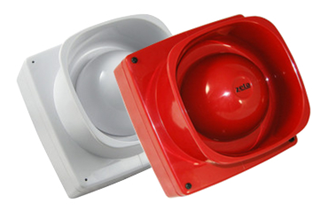 |
|
The following figures gives a broad indication of the sound levels of the various alarm sounders. Also indicated are typical sound levels for various industrial and commercial situations. An alarm noise level of not less than 5 decibels above ambient should be provided in general areas for adequate audibility but in sleeping areas a minimum level in the order of 65 decibels and 75 decibels at a bed head to wake sleeping occupants. It should be noted that most dome hells are intended for use with flush conduit or wiring systems. For surface wiring or conduit installations surface mounting adaptor boxes are normally required. Generally bells, electronic sounders and small sirens are available for use with 6, 12, 24 and 48V d.c. Sirens are normally operated at mains voltage, single or three-phase depending on the motor rating. Outdoor sirens should be fitted with heaters and thermostats to protect against low temperature conditions. Public address systems may be used for alarms, and visual signals may be used in special circumstances.
Points to consider
- Operating voltage
- Installation with surface or flush conduit system
- Internal or weather-proof installations
- Bell gong size
- Colour
- Motor rating of sirens, note some sirens are rated for continuous duty whilst others are rated for limited time periods.
- Television interference suppression
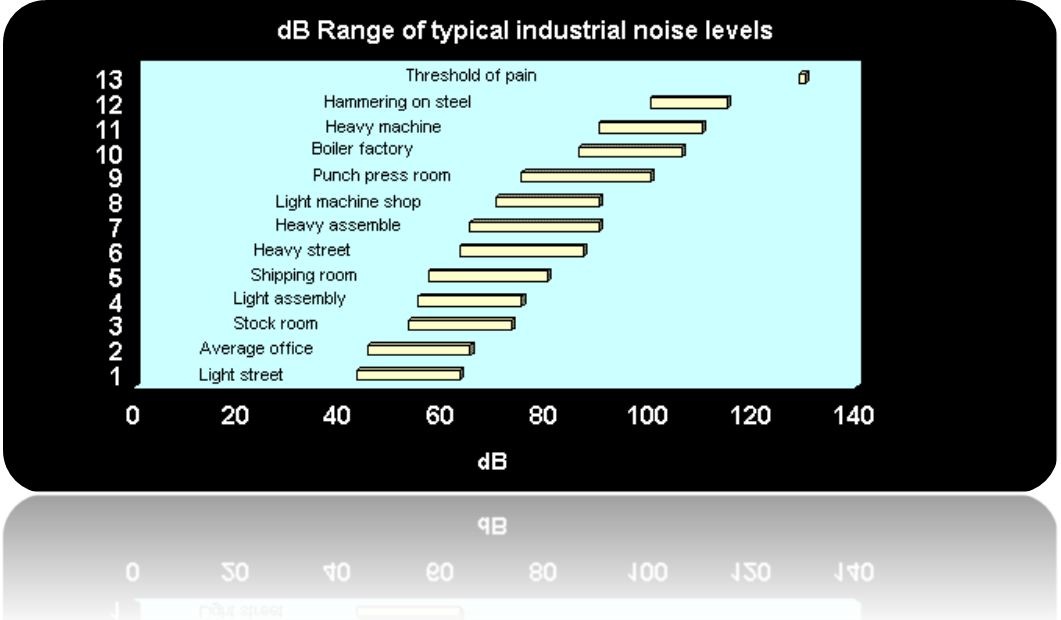
Whisper at three feet = 30dB
Casual conversation at three feet = 65dB
Threshold of pain = 130dB
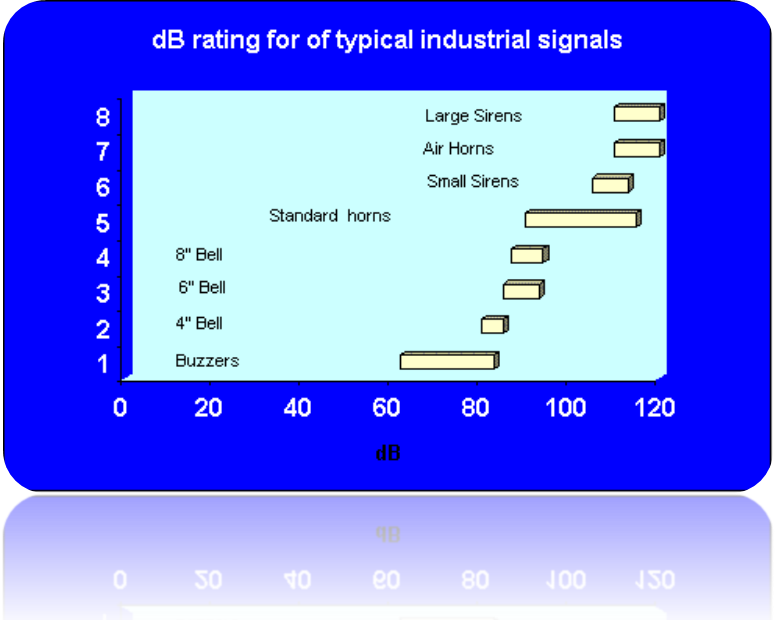
Power Units
Two power supplies are required i.e. mains and battery and these are normally built into the Fire Alarm Control Panel. Standby batteries must allow the system to operate without mains for 24 hours longer than the building is likely to be unoccupied and then support the sounders for an additional half hour. If the mains supply is supported by an emergency generator then six hours standby plus half an hour alarm load is sufficient. All modern Fire Alarm Systems are 24 volts. On the medium and larger sized Fire Alarm Systems, the standby batteries will often not fit within the Control Panel. Where standby batteries are contained within a separate housing, then this housing must be as close as possible to the main Fire Alarm Control Panel. If the power supply or battery housing is located more than 10 metres from the main Fire Alarm Control Panel then serious volt drop problems can arise. Standby batteries are invariably of the sealed lead acid variety. Use of Nickel Cadmium Batteries is not cost effective and automotive batteries must not be fitted.
Points to consider
- System voltage
- Battery charger output
- Battery capacity
- Indication of battery and/or mains supply failure
- Secondary battery exclusive to fire protection system
- Where system voltage exceeds extra-low voltage compliance






